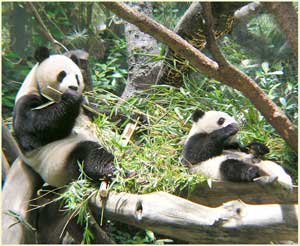The giant panda is one of the rarest animals in the world, primarily found in the mountainous regions of Sichuan, Gansu, and Shaanxi in China. Their numbers are very limited, and they are listed as protected species by the Chinese government. This animal is not only a rare treasure of China but is also considered a national symbol. The World Wildlife Fund has chosen the giant panda as its emblem and has designated it as a “peace ambassador” for China.
 |
|
(Photo: astrosurf) |
The giant panda is characterized by its stout body, soft fur, thick limbs, and can reach about 1.5 meters in length; standing around 60-70 cm tall and weighing between 100-180 kg. Their distinctive black eye patches resemble glasses, making them particularly beloved.
The ancestors of giant pandas were carnivorous, but they have adapted to a herbivorous diet, primarily consuming bamboo (Fargesia spathacea). An adult giant panda can eat approximately 20 kg of fresh bamboo each day. Occasionally, they break their dietary rules and hunt for bamboo rats in the bamboo forests. Sometimes, they even venture into human homes to steal food.
Giant pandas prefer solitude, foraging for food during the day and often moving to new locations seasonally. In spring, they inhabit bamboo forests at elevations of about 3000 meters above sea level. In summer, they seek shaded areas among young bamboo on sun-drenched slopes. In autumn, they move to sunnier locations at around 2500 meters to prepare for winter.
The breeding season for giant pandas occurs in April and May, during which male and female pandas come together. After May, they part ways. Female pandas have a gestation period of 4-5 months and seek out hollow trees or rock crevices to give birth, usually to 1-2 cubs. At birth, panda cubs weigh only about 150 grams, approximately 1/1000 of the mother’s weight. However, after just one month, they can weigh about 2 kg, and by three months, they reach 5-6 kg. Mother pandas are very nurturing, often carrying their cubs in their mouths or on their backs, refusing to let them out of sight. When the cubs are 5-6 months old and larger, the mother teaches them to climb, swim, bathe, and eat bamboo. It takes about two years for the young pandas to become independent and start living on their own. The lifespan of a giant panda is around 20-30 years.
The lineage of giant pandas is quite ancient. About one million years ago, they were widely distributed across the provinces of Shaanxi, Shanxi, Beijing, Yunnan, Sichuan, Zhejiang, Fujian, and Taiwan. Today, however, their numbers have dwindled significantly, making them a “living fossil” for scientists studying animal evolution.

(Photo: terrambiente)


















































